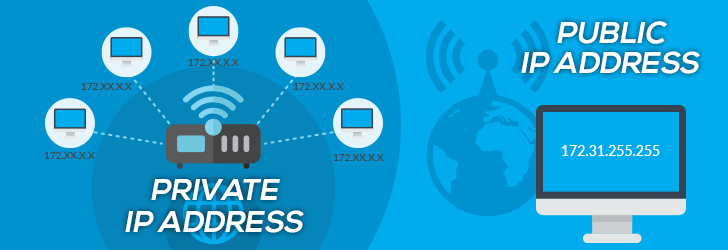
A public IP address is an IP address that can be accessed over the Internet. Like a postal address used to deliver postal mail to your home, a public IP address is the globally unique IP address assigned to a computing device. Your public IP address can be found at What is my IP Address page. A private IP address, on the other hand, is used to assign computers within your private space without letting them be directly exposed to the Internet. For example, if you have multiple computers within your home you may want to use private IP addresses to address each computer within your home. In this scenario, your router gets the public IP address, and each of the computers, tablets, and smartphones connected to your router (via wired or Wi-Fi) gets a private IP address from your router via DHCP protocol.
Internet Assigned Numbers Authority (IANA) is the organization responsible for registering IP address ranges to organizations and Internet Service Providers (ISPs). To allow organizations to freely assign private IP addresses, the Network Information Center (InterNIC) has reserved certain address blocks for private use. The following IP blocks are reserved for private IP addresses.
| Class | Starting IP Address | Ending IP Address | # of Hosts |
|---|---|---|---|
| A | 10.0.0.0 | 10.255.255.255 | 16,777,216 |
| B | 172.16.0.0 | 172.31.255.255 | 1,048,576 |
| C | 192.168.0.0 | 192.168.255.255 | 65,536 |
What is a public IP address?
A public IP address is the address that is assigned to a computing device to allow direct access over the Internet. A web server, email server, and any server device directly accessible from the Internet are candidates for a public IP address. A public IP address is globally unique, and can only be assigned to a unique device.
What is a private IP address?
A private IP address is the address space allocated by InterNIC to allow organizations to create their own private network. There are three IP blocks (1 class A, 1 class B, and 1 class C) reserved for private use. The computers, tablets, and smartphones sitting behind your home, and the personal computers within an organization are usually assigned private IP addresses. A network printer residing in your home is assigned a private address so that only your family can print to your local printer.
When a computer is assigned a private IP address, the local devices see this computer via its private IP address. However, the devices residing outside of your local network cannot directly communicate via the private IP address but use your router's public IP address to communicate. To allow direct access to a local device that is assigned a private IP address, a Network Address Translator (NAT) should be used.
Share this post
Leave a comment
All comments are moderated. Spammy and bot submitted comments are deleted. Please submit the comments that are helpful to others, and we'll approve your comments. A comment that includes outbound link will only be approved if the content is relevant to the topic, and has some value to our readers.

Comments (0)
No comment